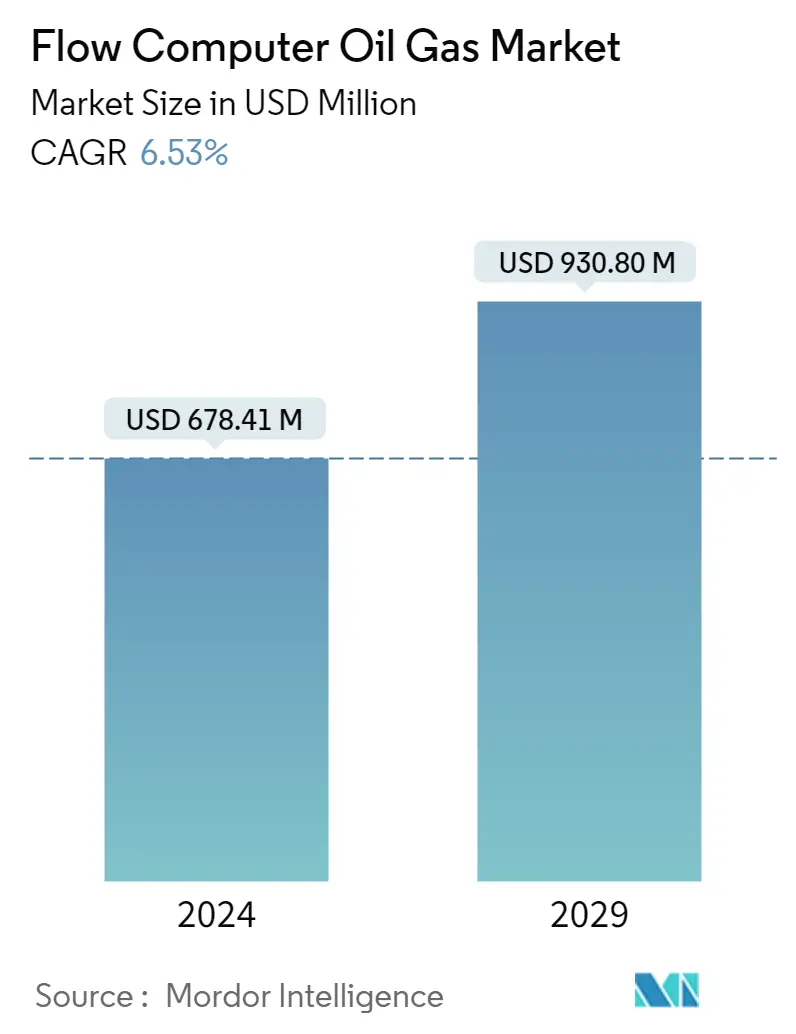Market Size of Flow Computer Oil Gas Industry

| Study Period | 2019 - 2029 |
| Market Size (2024) | USD 678.41 Million |
| Market Size (2029) | USD 930.80 Million |
| CAGR (2024 - 2029) | 6.53 % |
| Fastest Growing Market | Asia Pacific |
| Largest Market | North America |
Major Players
*Disclaimer: Major Players sorted in no particular order |
Need a report that reflects how COVID-19 has impacted this market and its growth?
Flow Computer Oil Gas Market Analysis
The Flow Computer Oil Gas Market size is estimated at USD 678.41 million in 2024, and is expected to reach USD 930.80 million by 2029, growing at a CAGR of 6.53% during the forecast period (2024-2029).
The overall function of a flow computer is to calculate and record the flow rate using industry-standard algorithms as natural gas and several hydrocarbons pass through a segmented section of the pipeline. These meters could be but are not limited to orifice meters, ultrasonic meters, linear meters, or Coriolis meters. A typical orifice measurement application requires a differential pressure transmitter, static pressure transducer, and temperature probe.
- Traditional oil and gas production site designs had one or two wells per pad. In contrast, modern production well pad designs integrate numerous wells, each of which may produce oil, natural gas, and water. Whereas wellhead and facility controls were once performed in separate locations, many more sites perform everything at the same location: the well pad. The economics of the modern oil and gas field requires concentrating measurement and control in a single location.
- The concentration at the wellhead has increased the demand for flow computers, which are supported by sophisticated control algorithms and the ability to provide real-time and historical data to multiple users. As more and more users discover the competitive advantage and productivity improvements they can gain from better data analysis and the requirements to collect, store, process, and transmit data, increasing the demand for high-tech flow computers increases.
- The development of a rugged, single platform equipped with consolidated measurement and controls, edge computing, advanced connectivity, and intrinsic cybersecurity is being sought after by many players in the oil and gas industry. This factor has led to expanding flow computer processing capabilities.
- The most critical risks that a company will face if somebody gets unauthorized access to oil and gas companies' infrastructure are planted sabotage/shutdown, equipment damage, production disruption, utility interruption, product quality, undetected spills, compliance violation, illegal pipeline tapping, safety violation, etc. Specific tactics threaten hackers to try and compromise communications or find a way to maintain a presence in corporate networks for espionage purposes, such as DNS hijacking, attacking webmail and corporate VPN servers, or even scraping publicly available information for data.
- Due to the COVID-19 pandemic, the oil and gas industry witnessed a slowdown in supply growth in the United States and other non-OPEC countries. The global oil demand is expected to contract in 2020, according to a study by the International Energy Agency (IEA). IEA had predicted that the daily need for crude oil was likely to decrease in 2020, from 100.1 million barrels in 2019 to 91.7 million barrels in 2020, due to the economic and mobility impacts of the COVID-19 pandemic which included widespread shutdowns across the world.
